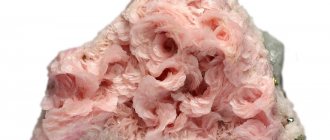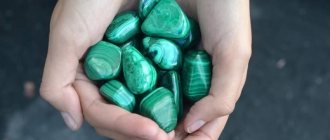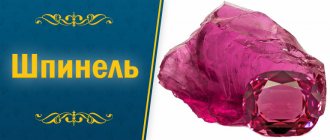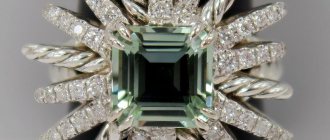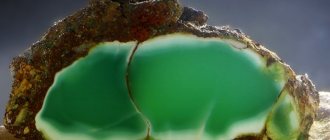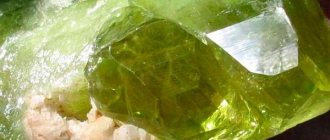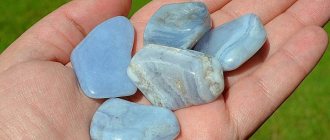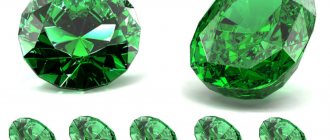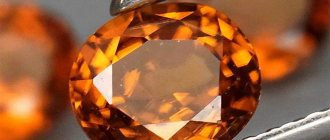The name “eudialyte” itself comes from the ancient Greek word “eudiálitos”, which means “easily soluble”. There are also additional names for this stone: almandine spar, Sami or Lapp blood.
It is interesting to consider why the name of the stone is associated with blood. There is a well-known legend that describes events since the existence of the ancient Sami. One day the Swedes attacked the Sami land, but the Sami won this brutal battle for freedom and independence. And in those places where the blood of warriors was shed, dark red gems appeared. Since then, the mineral has acquired such an unusual name. There are also stones of burgundy and crimson colors with white and gray splashes, which makes eudialyte truly beautiful.
History and origin
Eudialyte is of igneous origin and occurs in agpaitic nepheline syenites and their pegmatites. In eudialyte lujavrites of the Lovozero massif (Kola Peninsula) it is a rock-forming mineral.
Exhibit – Eudialyte
The name of the stone translates as “easily soluble”, and this is not an accident. Eudialyte can be easily melted in any acid (except hydrochloric acid). It may also be damaged due to high ambient temperatures. If the mineral is kept in direct sunlight for a long time, nothing will remain of it.
REFERENCE! The scientific name for the stone was given by the German chemist Friedrich Strohmeyer (1818).
The second name for eudialyte is Sami blood. One beautiful legend is connected with this: once the Swedes attacked the Sami land, but received a worthy rebuff. However, not all Sami leaders survived such an onslaught. And in place of their shed blood, stones appeared: they became real talismans for people.
On the Kola Peninsula it has a third name - “Lapp blood”.
Eudialyte – “Sami blood”
View all products from Eudialyte>>>
A long time ago, in distant Lapland, the Sami revered their idol gods - seids. Between the gloomy steep cliffs of Luyavr-Urta, above the sacred transparent Seydyavr Lake, the terrible old man Kuyva found his eternal shelter. Turned into a shadow on a rock by the gods for attacking the Sami, it is still there, huge and black, and still inspires the same fear in people as it did hundreds of years ago. Since then, red stones have been found in these places. Ancient legends say that it was his, Kuyva’s, drops of blood that turned into these very stones. From the dossier:
Eudialyte
is a complex sodium, calcium, zirconium silicate with variable composition, with inclusions of rare earth elements.
Hardness 5.0-5.5 on the Mohs scale, density 2.6-3.1 g/cm3, glass luster. Other names: Sami blood, Lapp blood, almandine spar (obsolete) Eudialyte is a rare mineral of a very beautiful deep burgundy-red tone.
The specimens from Greenland were named in 1819 by the German chemist Friedrich Strohmeyer, the discoverer of the metal cadmium. Translated from Greek, this name means “easily soluble stone” (eudi?litos). Eudialyte received this name due to its chemical properties: it easily melts in acids. This mineral was discovered and first described in Russia by Wilhelm Ramsay, a Finnish geologist (this honor is often mistakenly attributed to its namesake William Ramsay, a Scottish chemist and Nobel laureate). The results of research with descriptions of nine new minerals of the Lovozero massif of the Kola Peninsula were published by V. Ramsay in the journal “Fennia” for 1890. Among them was eudialyte. It is surprising in that its composition is not constant: it may contain noticeable quantities of rare cerium, lanthanum, yttrium, etc., and if eudialyte forms large accumulations, then it is an industrial source of zirconium - a rather rare metal, alloys based on which are used in nuclear energy. Without exaggeration, we can say that this amazing mineral contains a third of the periodic table. Millions of years ago, at a depth of several kilometers, this fiery red stone was born in volcanic molten magma. In nature, eudialyte forms irregular grains and dense granular masses, surrounded by other minerals and occasionally transparent crystals. Eudialyte is mainly used as an ornamental stone: it is quite hard and polishes well, but its color is especially attractive - a range from dark red, burgundy to raspberry and purple-cherry interspersed with black and milky gray. Other colors, such as carmine red, orange, yellow, tan, brown-red, violet, pink, are associated with the processes of change in the mineral and its decomposition. Eudialyte is mined in Russia on the Kola Peninsula, Norway, Tuva, Greenland (Ilimausak), Canada (Quebec, Mount St. Hilary), USA (Arkansas), Madagascar. The most extensive reserves of eudialyte are located in Greenland and the Kola Peninsula, with Russia in first place in terms of quantity and quality. From here, eudialyte is mainly distributed throughout the world. The pegmatites of the Khibiny massif are a well-known source of rare minerals, such as tinguaite, amazonite or kyanite (in general, there are more than 600 minerals in the Khibiny!), eudialyte was among them. The Kola Peninsula is even called the “treasure peninsula” for the huge amount of rare and beautiful minerals lying in its depths. Local residents - the Sami - call eudialytes "Lapp" or "Sami blood". The origin of this folk name is connected with the legend about the struggle of the Sami with the Swedes, which was outlined by academician A.E. Fersman in the famous book “Memories of the Stone” and which is somewhat different from the folklore version: “And they went to a real war - some with a shotgun, some just with a knife, they all went at the Swedes, and the Swede was strong and was not afraid of the lopi. First, he cunningly lured our lop to Seydyavr (Seydozero) and began to crumble it. If it hits to the right, ten of ours were missing, and drops of blood splashed all over the mountains, the tundra and the Khibiny Mountains, and it hit to the left, so again ten of ours were missing, and again drops of Lop’s blood were splashed across the tundra.” The Sami defeated Kuyva, the Swedish leader-hero, of whom only a shadow remained on the rock above Seydyavr, and the red drops of Sami blood, scattered across the tundra, turned into beautiful stones, which to this day, with their color, remind of the struggle of the Sami for their land. Eudialyte can be found both in jewelry and in stone-cutting art: boxes, balls, pyramids, eggs, panels, various dagger plates, etc. Its attractive appearance and variety of shades make it a welcome guest in the collections of gem lovers, and the wonderful range of shades, glass luster and richness of the pattern do not require any special processing from stone cutters other than polishing. Ruby-red intergrown crystals of "Sami blood" are sometimes embedded in a mass of black fibrous aegirine, golden astrophyllite or green nepheline, creating a stunning color palette. Black aegirine often forms thick needles that pierce eudialyte crystals, like Cupid's arrows piercing the hearts of lovers. This rock is called khibinite and consists of eudialyte, astrophyllite, nepheline, microcline and aegirine. Writing instruments, vases, and boxes are made from khibinite, in which it looks most impressive. Moreover, there are varieties of eudialyte that are often confused with it, for example, barsanovite - a stone of a reddish-brown color, less often yellowish-green. There is also ikranite (yellow grains) and tsvestaevite (bright pink crystals). All of these minerals are sometimes called eudialytes, especially the crystals. Red stone crystals have attracted the attention of jewelers, since the Kola Peninsula has rich deposits of eudialyte ore, and they can be easily cut. Oddly enough, eudialyte was previously used for finishing buildings. For example, the pedestal of the monument to V.I. Lenin in Murmansk is made from it. Now, interest in it has grown, and not only as a semi-precious stone, an object of jewelry and stone cutting, but also as a source of zirconium, and not only in Russia. In particular, one of the large mining companies in Australia has already equipped its representatives, who visited Apatity and met with geologists from the Kola Science Center. Undoubtedly, eudialyte is one of the most remarkable gems of modern times in every sense. This blood-colored stone has already earned several nicknames related to its healing and magical properties. One of them - the “stone of the heartland” - is associated with the positive effect of eudialyte on the heart and circulatory system, according to lithotherapists. In addition to the fact that eudialyte is able to cleanse the circulatory system, it also serves to prevent pancreatitis and improve the functioning of the pancreas. In this case, it is recommended to wear eudialyte products or even a raw stone on the stomach. “Lopar blood” is considered a good helper in replenishing energy after severe overexertion of the body, as well as in increasing vitality. Some lithotherapists suggest that eudialyte even affects the brain, and more precisely, the alpha rhythms of the brain; in addition, it can be used as a means to reduce eye pressure and, as a result, improve vision. This effect is possible when contemplating the smooth surface of a gem. As a stone of the heart, eudialyte brings harmony to emotional life, inspires confidence, opens inspiration, and most importantly, dispels jealousy. He is also nicknamed the "adjuster" for bringing the main and heart chakras into harmony, but his main influence is on the fourth, heart chakra, which he is considered to be able to open and activate. Thanks to these properties, “Lapp blood” accelerates recovery from depressive states, and is also a remedy for melancholy and melancholy, it is believed that with its help it is possible to learn to trust oneself and one’s judgments, i.e. become confident in your abilities and overcome your own weaknesses, even if you have to go through fear, pain or sadness. The next level of influence of eudialyte is getting rid of biased judgments and behavior caused by them. Under the influence of the energy of the stone, a person can feel a sense of awakening new levels of consciousness, which will help him better convey his emotions, teach him self-expression and understanding of his path. In particular, eudialyte is considered an aid to clairaudience, a supernatural ability similar to clairvoyance, a stone that facilitates extrasensory perception. This is not accidental, because the homeland of Russian red stones - the Kola Peninsula - is, according to some researchers, a biogenic zone, a place with positive energy, where a person’s well-being improves, his performance increases, creative and spiritual possibilities are revealed, and in general, vital forces are activated. This mysterious place is one of those where Bigfoot has been seen. Eudialyte amulets have the ability to enhance any energy, bring the owner a sense of self-confidence, give courage and invulnerability. Therefore, it can be considered the stone of warriors, pioneers, and in general people whose professional activities involve risk to life. Women are recommended to wear a bracelet made of eudialyte as a talisman; men can buy a talisman keychain. The effect of this mineral is similar to that of ruby, only stronger, especially in relation to sexuality. You should not wear items made from “Sami blood” constantly or with other stones, although, for example, balls made from this gem can be used quite often. Eudialyte is the patron saint of people born under the sign of Virgo. It is believed that he can bring much more benefit to them than to other signs. Eudialyte may well become a lucky talisman for Leo and Sagittarius. Like a deity, poems were dedicated to him, books were written about him and legends were made, and yet eudialyte does not yet take its rightful place in popularity among other gems, which is a pity! In its richness of tones and patterns, it can compete with the best and representatives of the mineralogical world. Once you see it, it is impossible to forget it, as if the magic of the mysterious Kola land is taking effect. So academician Alexander Fersman, the “poet of stone,” fell under the influence of eudialyte, having heard the legend of “Sami blood,” and in his “mineralogical novels” he sang about the stone, the color of life itself: “And there is no equal to it in the whole world, just as there is nothing dearer human blood shed for freedom and life.” View all products from Eudialyte>>>
Field
If we talk about the stone deposit in scientific terms, it is worth mentioning volcanic activity. The mineral formed as an igneous rock. The largest location of eudialyte deposits is located on the Kola Peninsula. It can also be found in the following geographical locations:
- USA;
- Austria;
- SOUTH AFRICA;
- Canada;
- Greenland;
- Norway;
- island of Madagascar.
Small specimens of stone are practically never found; large sizes predominate.
Eudialyte products and decorations
Eudialyte kit
Jewelers most often process the stone as a cabochon and encase it in silver, so it looks most advantageous. Silver jewelry with it can be purchased at the following prices:
- Ring for 100 dollars.
- Necklace with small inserts for $90.
- Leather cufflinks with small triangular stones for $40.
- Bracelet with several inserts for 130-150 dollars.
- Set of pendant + earrings for $120.
Eudialyte is practically not found in gold, but the market is full of souvenirs from it, for example:
- Boxes - cost 50-2000 dollars.
- Cubes - $80.
- Balls - 20-200 dollars.
- And others.
Simply processed cabochon copies are also sold in relevant stores. Their prices range from $7 to $30.
Physical properties
The main characteristics of eudialyte can be described as follows:
- The stone is a ring silicate of calcium, sodium and strontium.
- It is practically never found in its pure form. Titanium or potassium may act as impurities.
- Eudialyte is recognized as semi-precious.
- The nugget has a glassy luster and a transparent granular structure (partially or completely).
- The mineral is soft.
- Representative of the alkaline group of rocks.
- The vast voids of the stone are occupied by water particles and anions.
Jewelers are often attracted by its glow inside, but processing eudialyte can be very dangerous due to the inclusion of radioactive elements in its composition. The highest radiation activity was observed in bright red stones.
| Property | Description |
| Formula | Na4(CaCeFeMn)2ZrSi6O17(OHCl)2 |
| Impurity | Sr, Nb, Ti, K |
| Hardness | 5 — 5,5 |
| Density | 2.8 - 3 g/cm³ |
| Refractive index | 1,598 — 1,602 |
| singonia | Trigonal |
| Kink | Rough or conchoidal |
| Cleavage | Imperfect by {0001} |
| Shine | Glass |
| Transparency | Transparent or translucent |
| Color | Red, yellow, tan, purple |
Description
Eudialyte is a mineral with a glassy luster, transparent in thin sheets. Red shades - from pink to crimson - are considered classics. There are yellow, brownish, purple specimens.
Crystals are rare, most often they are coarse-grained agglomerates interspersed with eudialytes (the so-called “chintz”) among nephelines and apatites.
The unique feature of eudialyte is its crystalline structure. It is a combination of three rings (calcium and zirconium octahedrons plus silicon tetrahedrons).
The mineral kakortokite is also valuable to the Sami. This is nepheline with red and black inclusions of eudialyte and aegirine. It is mined only in the Khibiny Mountains and Greenland. Kakortokite and eudialyte are the main talismans of this people.
Varieties and colors
In nature, there are most red and brown shades of stone; they have white inclusions. Externally, eudialyte resembles garnet. There are also purple, brown and yellow-brown specimens.
Depending on the color, there are several types of eudialyte:
- barsanovite (can be red-brown or yellow-green);
- eucolite (predominance of all dark colors);
- ikranit (looks like yellow grain);
- blossom (reddish-pink shades).
Also read: Phenakite - a deceptive double of quartz
The colors will directly depend on the formation process, as well as on the depth at which the stone was located and its location.
Areas of application
Eudialyte is not very actively used for making jewelry. There are two reasons for this: the rarity of the mineral and the presence of strontium in its composition. Processing large stones is not allowed. But due to its igneous origin, the nugget is still considered a valuable raw material in terms of finding rare metals.
The most common form of cut stone is a polished cabochon, which is then set into rings, earrings and pendants. Only this method allows you to maximize the play of color impurities contained in the mineral. In the second half of the 19th century, there was a massive flowering of spiritualism - magic balls began to be made from large crystals.
Ring with stone
Beads
Earrings
Bracelet
In stone cutting, the mineral is used to make souvenirs, candlesticks, figurines and ashtrays. Craftsmen generously decorate various products with eudialyte. Beads go well with stone.
Where is the mineral used?
The unique composition and beauty of the mineral determined the scope of its use.
Industry
Eudialyte ore is a source of rare earth metals. There are more than half of them in the mineral (up to 60%). These are the most valuable for industry, new technologies and science: hafnium, niobium, tantalum, titanium, zirconium, strontium.
Eudialyte breed
However, strontium creates weak radioactivity. This is not dangerous in small nuggets and after processing the mineral is zero.
Jewelry
Physical properties limit the range of eudialyte jewelry. Crystals, if they occur, are small. The use of large ones is prohibited due to radioactivity.
Original nuggets are polished cabochon: the play of colored impurities is revealed to the fullest.
Earrings with eudialyte
Agglomerates are in demand, including two types of stones. For example, white apatite and red eudialyte. A product with such an insert looks more impressive.
Decor
Stone carvers dominate the production of a wide range of stone products. They make small plastic compartments. A box made of eudialyte is not cheap (10–12 thousand rubles), but it looks premium. The gem is used to frame mirrors, decorate lighters and dishes.
Lovers of esotericism are not forgotten either. Magic spheres, eudialyte eggs, and pendulums are crushed for them. The very structure of the stone creates a mysterious glow. This property allows you to distinguish a real stone from a fake one.
Medicinal properties
Official medicine is wary of stone treatment, but fans of non-standard methods of fighting diseases are ready to challenge the opposite point of view.
- Traditional healers called eudialyte “the stone of the heartland” - it affects the state of the cardiovascular system in the most positive way. The functioning of the heart muscle improves, vascular pathologies disappear, and blood pressure normalizes.
- If you wear this mineral in the form of a pendant at the level of the abdomen, it will help cope with diseases such as ulcers and gastritis.
- Eudialyte is used for vision problems: the unusual pattern on the stone relieves eye strain.
- Nugget is a means of prevention in the fight against pancreatitis.
- It also lowers cholesterol levels in the blood and generally improves its composition and saturates it with oxygen.
- The stone relieves obsessive thoughts.
- Depression and stressful situations with eudialyte fade into the background.
ATTENTION! Stone healing can only be used as a means of prevention or as an addition to the main treatment. In case of serious problems, you should contact a doctor.
Healing effect
Since ancient times, radioactive crystal has been used in healing practices. It was called “the stone of the heartland.” Treatment consisted of applying the mineral to sore spots. The stones used varied in size, composition and level of radioactivity. During the procedure, spells of varying lengths were recited. The spell regulated the duration of the session.
In the modern world, irradiation of radioactive elements is used to treat many diseases. Eudialyte plates are used in the treatment of:
- Gastric ulcer;
- Heart and blood vessels;
- Problems with the kidneys and liver;
- Pancreatitis, inflammation of the pancreas;
Normalizes eye pressure during color therapy sessions, improves vision, relieves fatigue and irritation.
Eudialyte will help concentrate internal strength and pull yourself out of a depressed state.
Magic properties
The magical properties of this stone have been fully studied by esotericists.
- Experts have come to a consensus that eudialyte protects against wounds and various injuries (bruises, abrasions, contusions).
- The mineral promotes making the right decision. To understand yourself, you just need to take eudialyte in your hands, turn off your emotions and think about the current situation.
- The stone develops intuition and teaches you to trust your own feelings.
- Eudialyte helps solve career guidance issues and also improves thought processes.
- Such a talisman is responsible for spiritual development and creative self-determination.
- Eudialyte increases the attractiveness of men in the eyes of the fair half of humanity.
- This is a stone of inexhaustible and immense passion. You need it if you want to strengthen your love feelings for your partner.
- “Sami blood” is needed by people who risk their lives every day: police officers, rescuers, firefighters. It’s good to take such a trophy with you on a long journey.
- Magicians believe that this mineral helps develop psychic abilities.
Also read: Pomegranate – the grain of the “Phoenician apple”
Stone jewelry
REFERENCE! Ancient warriors believed that eudialyte turned cowardly people into brave men, so they always kept it near them during battles.
Talismans and amulets
The Sami have long believed that eudialyte makes any man a man, and a coward into a brave man, and that it is the main protector of warriors in battle.
This belief is reflected in modern times. People in extreme professions should stock up on an amulet with eudialyte - military, police, sappers, rescuers, firefighters, as well as simply extreme people in life.
The eudialyte amulet will protect everyone else from physical damage - bruises, fractures, abrasions and all sorts of other wounds, and will also not allow anyone to interfere with their thoughts, impose their opinions and manipulate their feelings.
The pebble will also help on long journeys; it will protect its owner from misunderstanding and troubles in a foreign land.
A talisman with eudialyte will be useful for single men to attract female attention.
Married couples will also appreciate the magical capabilities of the Sami stone. It will strengthen relationships, help find mutual understanding, and return the spouses to their former passion.
Eudialyte exhibits maximum power as an amulet in a silver frame. Silver also enhances the healing properties of the gem.
Jewelry with mineral
Eudialyte cannot be worn simultaneously with other minerals: it can enhance the magical properties of foreign stones, which is not always a plus. After all, many minerals, along with positive properties, are also endowed with negative ones.
In order for the stone to have the opportunity to maximize its potential, it is best for women to wear eudialyte in a silver frame in the form of jewelry (rings or bracelets), and for men - in the form of a key ring.
Given the radioactivity of the mineral, it should be kept away from the thyroid gland and those areas of the skin where moles are present.
Eudialyte is also known as a “double stone” for jewelry. This applies to those specimens where the predominant shares are occupied by two minerals at once - eudialyte and some other one (for example, apatite). After processing, a unique white-red gem is obtained. It is highly regarded by collectors.
Crystal structure
The structure of eudialyte, which is highly complex, was deciphered by Giusepetti and co-authors using material from Naujakasik (Greenland) (composition, according to X-ray chemical analysis: Na2O - 13.6, K2O - 0.5, CaO - 11.0, MnO - 0.4, FeO - 6.4, Fe2O3 - 0.5, TR2O3 - 1.3, SiO2 - 49.1, ZrO2 - 14.0, Nb2O5 - 1.1, H2O - 1.1, Cl - 1.2%) and independently of them, Golyshev et al. (1971) based on material from the Khibiny massif. A feature of the structure is the simultaneous presence of two types of Si - O-rings in it: triple [Si3O9] (as in catapleite) and nine-membered [Si9O27] (so far discovered only in eudialyte). In the latter, [Si2O7] diortho groups alternate with single SiO4 tetrahedra turned inside the rings; The valence of internal O atoms in tetrahedra is not saturated, their place is probably occupied by OH groups - [Si9O24(OH)3].
Along the period c (~30 A), 12 floors separated by O atoms are distinguished, breaking up into three mica-like packages. In each package, the “core” of Zr(+Nа)O6 octahedra is covered from below and above by triple [Si3O9] and nine-ring [Si9O27] rings, alternating along three-order axes. Between the packets there are CaO6 octahedra, connected by edges into six-ring rings, which are covered above and below by triple [Si3O9] rings, and border [Si9O27] rings along the periphery. Rings of CaO6 octahedra are placed at the nodes of the hexagonal mesh, uniting through Fe2+ polyhedra of an unusual square configuration into a continuous openwork mesh. Na+ ions are located in the interstices of the cationic and anionic layers of the structure. Six Na atoms are located in the Zr “cores” and six in the silicon-oxygen rings, i.e. Na occupies a different position than Ca. The arrangement of atoms in the structure corresponds to the centrosymmetric law (R3m), but the Na atoms are significantly displaced, which causes a decrease in symmetry to R3m and the manifestation of a piezoelectric effect in some stones. Along the triple axes in the structure there are cavities of different sizes and configurations in which additional cations and anions capable of ion-exchange substitutions are located. In this way, its structure resembles the structure of feldspathoids or zeolites. According to Golyshev et al., a fairly large K+ cation can enter the cavity inside the six-ring ring of CaO6 octahedra, and two large Cl atoms can enter the cavities surrounded by three Na atoms from the Zr “core” and three Na atoms from the silicon-oxygen ring. The center of the nine-fold silicon-oxygen rings can accommodate two additional Si atoms; in this case, the 3 (OH) of the internal tetrahedra are replaced by O, the free vertex of the tetrahedra is completed by an OH group, and the [Si9O24(OH)3]15- radical is transformed into [Si1oO27(OH)]15-. However, Giusepetti and co-authors assumed that the center of the nine-fold silicon-oxygen ring contains not Si, but an additional fourth Zr atom. The dimensions of these cavities allow the inclusion of Cl instead of Si (or Zr). Additional Na atoms can be statistically distributed in smaller voids. In total, 4Na + K and 2Cl or 3Na + K + Si and 2Cl + (OH) or 2Na + K + + 2Si and 2Cl + 2(OH) can enter the voids of the framework (calculated per rhombohedral cell).
How to wear and care
Eudialyte needs careful care. The stones subtly feel the care of the owner: over time they will definitely reciprocate:
- Eudialyte is stored in a cool place: the stone may not tolerate high temperatures.
- Wash it in running cool water; no additional cleaning agents are required.
- Be careful when wearing it: the stone is soft and easy to scratch.
- If washing the eudialyte does not bring noticeable results, take it to a jeweler for professional cleaning. A specialist should help.
- Be extremely careful: if the eudialyte is damaged, the level of radiation around it may increase.
- Store it in a soft bag, which is best kept in a dark place.
- Be sure to take off your jewelry if you plan to play sports or visit the beach.
Stone care
Eudialyte earrings
Eudialyte is very sensitive to external influences, so it should be worn and stored with care:
- do not drop the stone, as it will instantly split;
- do not expose to high temperatures - eudialyte can melt even from the flame of an ordinary match or candle;
- do not allow acidic solutions to come into contact with the surface of the gem - some acids (for example, hydrochloric acid) can dissolve the stone;
- do not allow the stone to come into contact with household cleaning products, cosmetics and perfumes;
- Eudialyte should be washed with warm running water without any detergents.
Store the stone separately from other jewelry in a box or case with soft filling.
Astrological compatibility
From birth, every person has a specific set of stones that helps to skillfully manage internal energy and replenish it at the right time. Possessing rare magical abilities, eudialyte is “friends” with almost all signs of the zodiac.
Also read: Marcasite is a twin of pyrite with a poetic name
(“+++” – the stone fits perfectly, “+” – can be worn, “-” – is strictly contraindicated):
| Zodiac sign | Compatibility |
| Aries | + |
| Taurus | + |
| Twins | + |
| Cancer | + |
| a lion | + |
| Virgo | +++ |
| Scales | + |
| Scorpion | + |
| Sagittarius | + |
| Capricorn | + |
| Aquarius | + |
| Fish | + |
- The mineral is most recommended for Virgos. Especially if they have experienced a serious shock. The stone will take on a depressed state.
- As a talisman-amulet, it is ideal for Sagittarius. The main thing is to always carry it with you and not lose it.
- For Leos, eudialyte will help improve their personal life. However, to maintain the relationship, you will have to change a lot in yourself.
- For Aries, the stone acts as a means of protection. Bad dreams will stop tormenting you, and two-faced people will gossip behind your back less.
- For Aquarians, the nugget will tell them how to direct the irrepressible flow of energy into a peaceful channel. Perhaps you will finally find the business you have always dreamed of.
- For Pisces, this mineral will become synonymous with calm. You should not take any trifles to heart and let them pass through you.
- Geminis with eudialyte will find love. But what it will be like depends only on the representatives of the sign themselves. It could be love for a specific person, life or business.
- Libra knows harmony; they will fuss less.
- Scorpios will increase their willpower. Eudialyte also advises you to reconsider your circle of friends. Perhaps some of them are considered to be them only formally.
- In Capricorn, under the influence of the stone, negative character traits will become softer. Disadvantages can also sometimes be advantages.
- Cancers, acquiring eudialyte, will reconsider their views on life and realize their mistakes.
- Taurus will value their loved ones more and will place the main emphasis on family.
Is this stone right for you?
What zodiac signs is it suitable for?
The astrological properties of eudialyte are suitable for absolutely all zodiac signs. The only difference is that one person will feel a strong influence of the mineral, while another will feel weak or not at all.
Eudialyte is ideal for Virgos. Astrologers claim that a talisman with a red mineral will protect Virgos from ill-wishers, evil people, sorcerers and damage. The crystal attracts luck and luck. Many Virgos discover hidden talents in themselves after purchasing a product with eudialyte.
Interesting to know
- Artificially, under the influence of certain conditions, scientists obtained an analogue of eudialyte.
- In 1890, Wilhelm Ramsay, a professor at the Imperial Alexander University, published a description of nine different minerals in one of the scientific journals (eudialyte was among them). All of them were discovered by him as a result of research of the Lovozero massif. For this, the geologist was awarded a special prize from Alexander the Second.
A bright stone stores and protects its owner from wounds and blues. Jewelry with eudialyte is unforgettable and expressive. Such beautiful talismans open the way to new knowledge. Due to its characteristics, the mineral is considered almost the most fragile. So his intimidating appearance is just a mask.
5/5 — (1 vote)
Artificial production of mineral
Eudialyte was synthesized from a mixture of 6SiO2 + ZrO2 + 6Na2CO3 + CaCO3 + FeCl2 + 4H2O with Na2SiF6 or K2SiF6 in the temperature range 450-550°C at a water vapor pressure of 85-700 kgf/cm2. Formation occurred only in a highly alkaline environment (with an excess of Na2CO3), in water vapor, with a significant predominance of Na over Al, in the presence of Ca and Cl (in a less alkaline environment and with a smaller excess of Na relative to Al, zircon crystallizes); in the presence of F, crystallization proceeds faster (isotropic or weakly anisotropic hexagonal eudialyte plates with n = 1.592 are obtained).
Diagnostic signs
Eudialyte is often mistaken for garnet. It differs from it in the shape of its crystals, less hardness, fragility, lower refractive indices, and easy decomposition in acids.
Associated minerals. Zircon, sodalite, molybdenite.
Eudialyte vein. Vekhovya rTalnakh


